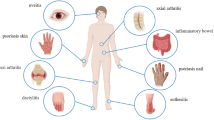Abstract
At present, rheumatoid arthritis (RA) is considered a type of autoimmune disease. Its pathology is not certain, and effective drugs with less toxicity have not been established. The establishment and application of animal models are effective methods for RA research, especially using animal models similar to humans. Arthritis is more heterogeneous, and this is an important starting point when discussing animal models for arthritis. Animal models are instrumental in understanding the etiology and pathogenetic mechanisms of RA. Appropriate animal models should be selected according to experiments because they have different traits. Various methods have been applied to induce arthritis in animal experimental models, which have provided important insights into the etiopathogenetic mechanisms of human RA. This review was written to give a broad introduction of the current stage of RA model and hope to offer beneficial help for RA-related research.


Similar content being viewed by others
References
Di Paola R, Cuzzocrea S (2008) Predictivity and sensitivity of animal models of arthritis. Autoimmun Rev 8(1):73–75
Dinser R (2008) Animal models for arthritis. Best Pract Res Clin Rheumatol 22(2):253–267
Huh JE, Hong JM, Baek YH et al (2011) Anti-inflammatory and anti-nociceptive effect of Betula platyphylla var. japonica in human interleukin-1beta-stimulated fibroblast-like synoviocytes and in experimental animal models. J Ethnopharmacol 135(1):126–134
Chang J, Kavanaugh A (2005) Novel therapies for rheumatoid arthritis. Pathophysiology 12(3):217–225
Vital EM, Emery P (2008) The development of targeted therapies in rheumatoid arthritis. J Autoimmun 31(3):219–227
Villa-Forte A, Mandell BF (2011) Cardiovascular disorders and rheumatic disease. Rev Esp Cardiol 64(9):809–817
Zhang P, Han D, Tang T et al (2008) Inhibition of the development of collagen-induced arthritis in Wistar rats through vagus nerve suspension: a 3-month observation. Inflamm Res 57(7):322–328
Seeuws S, Jacques P, Van Praet J, Drennan M et al (2010) A multiparameter approach to monitor disease activity in collagen-induced arthritis. Arthritis Res Ther 12(4):R160
Carlsen S, Hansson AS, Olsson H et al (1998) Cartilage oligomeric matrix protein (COMP)-induced arthritis in rats. Clin Exp Immunol 114(3):477–484
Meyer DM, Jesson MI, Li X, Elrick MM et al (2010) Anti-inflammatory activity and neutrophil reductions mediated by the JAK1/JAK3 inhibitor, CP-690,550, in rat adjuvant-induced arthritis. J Inflamm (Lond) 7:41
Vingsbo C, Jonsson R, Holmdahl R (1995) Avridine-induced arthritis in rats; a T cell-dependent chronic disease influenced both by MHC genes and by non-MHC genes. Clin Exp Immunol 99(8):359–363
Zhu W, Meng L, Jiang C, Hou W, Xu J, Wang B et al (2011) Induction of toll-like receptor 2 positive antigen-presenting cells in spleen of pristane-induced arthritis in rats. Mol Biol Rep 39(3):3667–3673
Meng L, Zhu W, Jiang C, He X, Hou W et al (2010) Toll-like receptor 3 upregulation in macrophages participates in the initiation and maintenance of pristane-induced arthritis in rats. Arthritis Res Ther 12(3):R103
Jansson AM, Lorentzen JC, Bucht A (2000) CD8+ cells suppress oil-induced arthritis. Clin Exp Immunol 120(19):532–536
Perruche S, Saas P, Chen W (2009) Apoptotic cell-mediated suppression of streptococcal cell wall-induced arthritis is associated with alteration of macrophage function and local regulatory T-cell increase: a potential cell-based therapy? Arthritis Res Ther 11(4):R104
Nagate T, Tamura T, Sato F, Kuroda J et al (2007) Tranilast suppresses the disease development of the adjuvant- and streptococcal cell wall-induced arthritis in rats. J Pharmacol Sci 105(1):48–56
Holmdahl R, Bockermann R, Backlund J, Yamada H (2000) The molecular pathogenesis of collagen-induced arthritis in mice–a model for rheumatoid arthritis. Ageing Res Rev 1(1):135–147
Glant TT, Radacs M, Nagyeri G, Olasz K et al (2011) Proteoglycan-induced arthritis and recombinant human proteoglycan aggrecan G1 domain-induced arthritis in BALB/c mice resembling two subtypes of rheumatoid arthritis. Arthritis Rheum 63(5):1312–1321
Sakiniene E, Collins LV (2002) Combined antibiotic and free radical trap treatment is effective at combating Staphylococcus aureus-induced septic arthritis. Arthritis Res 4(1):196–200
Henningsson L, Jirholt P, Lindholm C, Eneljung T et al (2010) Interleukin-17A during local and systemic Staphylococcus aureus-induced arthritis in mice. Infect Immun 78(9):3783–3790
Ma Y, Seiler KP, Eichwald EJ, Weis JH et al (1998) Distinct characteristics of resistance to Borrelia burgdorferi-induced arthritis in C57BL/6N mice. Infect Immun 66(1):161–168
Kay J, Calabrese L (2004) The role of interleukin-1 in the pathogenesis of rheumatoid arthritis. Rheumatol (Oxford) 43(3):iii2–iii9
Pizarro TT, Arseneau KO, Cominelli F (2000) Lessons from genetically engineered animal models XI. Novel mouse models to study pathogenic mechanisms of Crohn’s disease. Am J Physiol Gastrointest Liver Physiol 278(1):G665–G669
Okura T, Marutsuka K, Hamada H, Sekimoto T et al (2008) Therapeutic efficacy of intra-articular adrenomedullin injection in antigen-induced arthritis in rabbits. Arthritis Res Ther 10(6):R133
Martinez-Lostao L, Garcia-Alvarez F, Basanez G, Alegre-Aguaron E et al (2010) Liposome-bound APO2L/TRAIL is an effective treatment in a rabbit model of rheumatoid arthritis. Arthritis Rheum 62(8):2272–2282
Benito MJ, Sanchez-Pernaute O, Lopez-Armada MJ, Hernandez P et al (2000) Cyclosporin A prevents the histologic damage of antigen arthritis without inducing fibrosis. Arthritis Rheum 43(2):311–319
Kranenburg HC, Westerveld LA, Verlaan JJ, Oner FC et al (2010) The dog as an animal model for DISH? Eur Spine J 19(8):1325–1329
Cook JL, Kuroki K, Visco D, Pelletier JP, Schulz L, Lafeber FP (2010) The OARSI histopathology initiative—recommendations for histological assessments of osteoarthritis in the dog. Osteoarthr Cartil 18(3):S66–S79
Mihara M, Kotoh M, Nishimoto N, Oda Y, Kumagai E et al (2001) Humanized antibody to human interleukin-6 receptor inhibits the development of collagen arthritis in cynomolgus monkeys. Clin Immunol 98(3):319–326
Kato A, Matsuo S, Takai H, Uchiyama Y, Mihara M, Suzuki M (2008) Early effects of tocilizumab on bone and bone marrow lesions in a collagen-induced arthritis monkey model. Exp Mol Pathol 84(3):262–270
Acknowledgements
This research was supported by National Natural Foundation of China (Support number: 81000786) and Shenzhen foundation (Number: 201103348)
Disclosures
None.
Author information
Authors and Affiliations
Corresponding author
Rights and permissions
About this article
Cite this article
Hu, Y., Cheng, W., Cai, W. et al. Advances in research on animal models of rheumatoid arthritis. Clin Rheumatol 32, 161–165 (2013). https://doi.org/10.1007/s10067-012-2041-1
Received:
Accepted:
Published:
Issue Date:
DOI: https://doi.org/10.1007/s10067-012-2041-1




